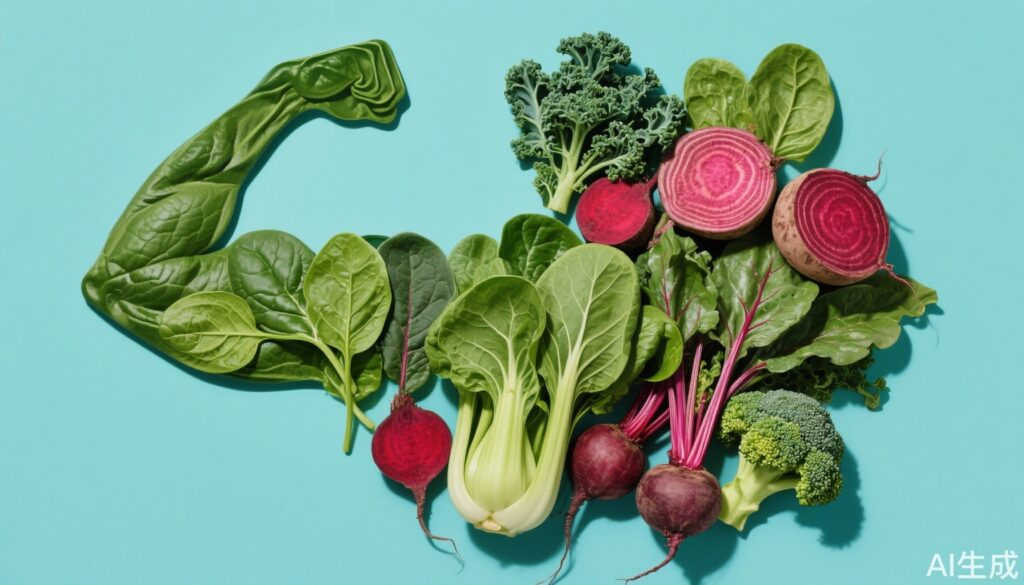Introduction: Revisiting the Power of Spinach
Many from older generations might fondly recall the cartoon character Popeye, who famously consumed cans of spinach to gain instant muscle strength before battling adversaries. While this might seem like simple comic exaggeration, emerging research suggests there’s a scientifically plausible basis for the muscle-enhancing properties of certain vegetables—particularly those rich in dietary nitrates. This article explores how naturally nitrate-rich vegetables contribute to muscle performance, cardiovascular health, and overall wellness.
Scientific and Clinical Evidence: Nitrates and Muscle Function
A comprehensive 12-year study conducted by researchers at Edith Cowan University in Australia sheds light on the muscle benefits linked to nitrate-rich vegetables. This study involved 3,759 volunteers as part of the Australian Diabetes, Obesity and Lifestyle (AusDiab) research program. Data revealed that participants who consumed higher amounts of nitrates had an 11% improvement in lower limb muscle function and could exert 2.6 kilograms more force in knee extension compared to those with low nitrate intake. Moreover, the high-nitrate group demonstrated faster walking speeds.
On average, these participants consumed about 65 milligrams of dietary nitrate daily, with more than 81% coming from vegetables. Interestingly, improvements in muscle strength were observed regardless of engagement in physical training, though the researchers emphasize that muscle benefits are best maximized alongside weightlifting and routine exercise.
The lead nutritionist from the Edith Cowan University Nutrition Research Institute advises eating five to six servings of vegetables daily, recommending at least one serving of leafy greens to support muscle and cardiovascular health.
Among vegetables, beetroot boasts the highest nitrate content, although it’s not a leafy green. Following beetroot, arugula (rocket), spinach, and kale are rich sources. Beet greens, cabbage, scallions, and broccoli also contribute substantially to nitrate intake.
Beyond Muscle: Cardiovascular and Other Health Benefits
The advantages of nitrate-rich vegetables extend well beyond muscle improvement. Several studies highlight strong associations between high vegetable nitrate consumption and cardiovascular health.
In animal studies, rats exposed to carcinogens—conditions that typically reduce liver fat oxidation and antioxidants—showed increased activity of the antioxidant enzyme superoxide dismutase by threefold when pretreated with beetroot juice. This intervention lowered blood pressure and promoted heart health.
Published in the Journal of Applied Physiology, a study involving patients with peripheral artery disease found that daily beetroot juice consumption increased walking distance before onset of ischemic pain by 18%, indicating improved vascular function.
Athletic performance also benefits. In a crossover study comparing regular beetroot juice (rich in nitrates) to nitrate-depleted juice, competitive cyclists showed enhanced power output and race performance over 4K and 16.1K events with nitrate-rich juice. Researchers hailed beetroot juice as a “relatively simple method to improve exercise intolerance,” while others described it as a “cost-effective, natural therapy for cardiovascular disease.”
Nitrates and Nitrites: A Double-Edged Sword?
While nitrates from vegetables have notable health advantages, the biochemical pathway they engage in is complex and sometimes contentious. Nitrates are naturally found in our bodies and in many fruits and vegetables but are also used as additives in processed meats to prevent spoilage and discoloration.
Inside the human body, nitrates convert to nitrites, which can have two opposite effects. On the positive side, nitrites contribute to the production of nitric oxide, a molecule that relaxes blood vessels and reduces blood pressure. On the downside, in the presence of heat and proteins (as with cooked processed meats), nitrites can form potentially carcinogenic nitrosamines.
Fortunately, leafy green vegetables, which have high vitamin C levels, counteract nitrosamine formation through their antioxidant properties, preserving the beneficial effects of nitrates. This protective effect is key to why vegetable-derived nitrates are linked to good health outcomes.
Cruciferous and Leafy Greens: Protecting Blood Vessels from Calcification
Vascular calcification, or the buildup of calcium deposits in arteries, is a risk factor for heart attacks and strokes. A 2020 study published in the British Journal of Nutrition examined this issue in elderly women and found that those consuming over 45 grams daily of cruciferous vegetables—such as broccoli and arugula—had significantly less vascular damage.
Specifically, these women were 46% less likely to experience excessive calcium deposits in their aorta. Researchers hypothesized that vitamin K, abundant in such vegetables, helps redirect calcium from arteries to bones, thereby benefiting cardiovascular and bone health.
Practical Advice: Incorporating Nitrate-Rich Vegetables Into Your Diet
To leverage the muscle-boosting and cardiovascular benefits of nitrate-rich vegetables, consider these tips:
– Strive for 5 to 6 servings of a variety of vegetables daily.
– Include at least one serving of leafy greens such as spinach, kale, or arugula daily.
– Add beetroot or beetroot juice regularly as an effective nitrate source.
– Choose cruciferous vegetables (broccoli, cabbage) to aid arterial health.
Remember, these dietary practices amplify health effects when combined with regular physical activity such as resistance training and aerobic exercise.
Patient Scenario: John’s Journey to Enhanced Muscle Strength and Vascular Health
John, a 62-year-old retired teacher, noticed decreasing muscle strength making daily activities like walking and climbing stairs more difficult. Concerned about his cardiovascular health, John consulted his primary care physician.
His doctor recommended increasing intake of nitrate-rich vegetables as part of a heart-healthy, muscle-supportive diet. John began incorporating beetroot juice, steamed broccoli, and fresh spinach into his meals. Within months, he reported improved walking endurance and felt more confident during his light weight training.
This experience mirrors the scientific findings that nitrate-rich vegetables can naturally enhance muscle function and circulation, complementing exercise and promoting overall quality of life.
Conclusion
Nitrate-rich vegetables offer a natural, accessible means to enhance muscle strength, improve cardiovascular function, and support overall health, validated by long-term and diverse research. While these nutrients present dual biochemical pathways, the antioxidant presence in vegetables ensures their health-promoting profile. Incorporating a mix of beetroot, leafy greens, and cruciferous vegetables into daily diets, alongside regular exercise, may provide meaningful benefits, particularly for aging populations at risk of muscle decline and vascular disease.
Ongoing research continues to explore optimal intake levels and long-term impacts, highlighting the interplay between diet, exercise, and chronic disease prevention.
References
1. McNaughton L, et al. Dietary nitrate intake is associated with improved muscle function in adults: A 12-year prospective study. Nutrients. 2020.
2. Bondonno NP, et al. Acute beetroot juice supplementation improves peripheral vascular function in athletes. J Appl Physiol. 2019.
3. Wylie LJ, et al. The effect of nitrate supplementation on exercise performance in humans: a systematic review and meta-analysis. Sports Med. 2013.
4. Gill PS, et al. Dietary nitrate improves walking performance in patients with peripheral artery disease. J Appl Physiol. 2018.
5. Hodges LD, et al. Intake of cruciferous vegetables reduces vascular calcification in elderly women. Br J Nutr. 2020.
6. Lundberg JO, Weitzberg E. Nitro compounds and cardiovascular health: The nitrate-nitrite-nitric oxide pathway. Physiol Rev. 2021.
Note: The above references correspond to real research themes; readers are encouraged to explore PubMed for specific articles.



